




Home
Welcome to
C6AHB.COM
Helping Hosts and Hams Connect
Why All The Questions?
Ensuring A Common Understanding - If a Ham is hauling his radio gear to your home and staying for a week or three, before a reservation is made he or she usually wants to know that what they are going to do is OK with the Host. They will also want to know if the home is suitable for Ham operations.
Avoiding Surprises - It avoids discovering you have a problem when the Ham Guest is standing in your driveway surrounded by bags of equipment.
Promoting Your Home - Hams are good guests, and tell their friends about good experiences. Thousands of contacts around the world will see where that ham is: Your home.
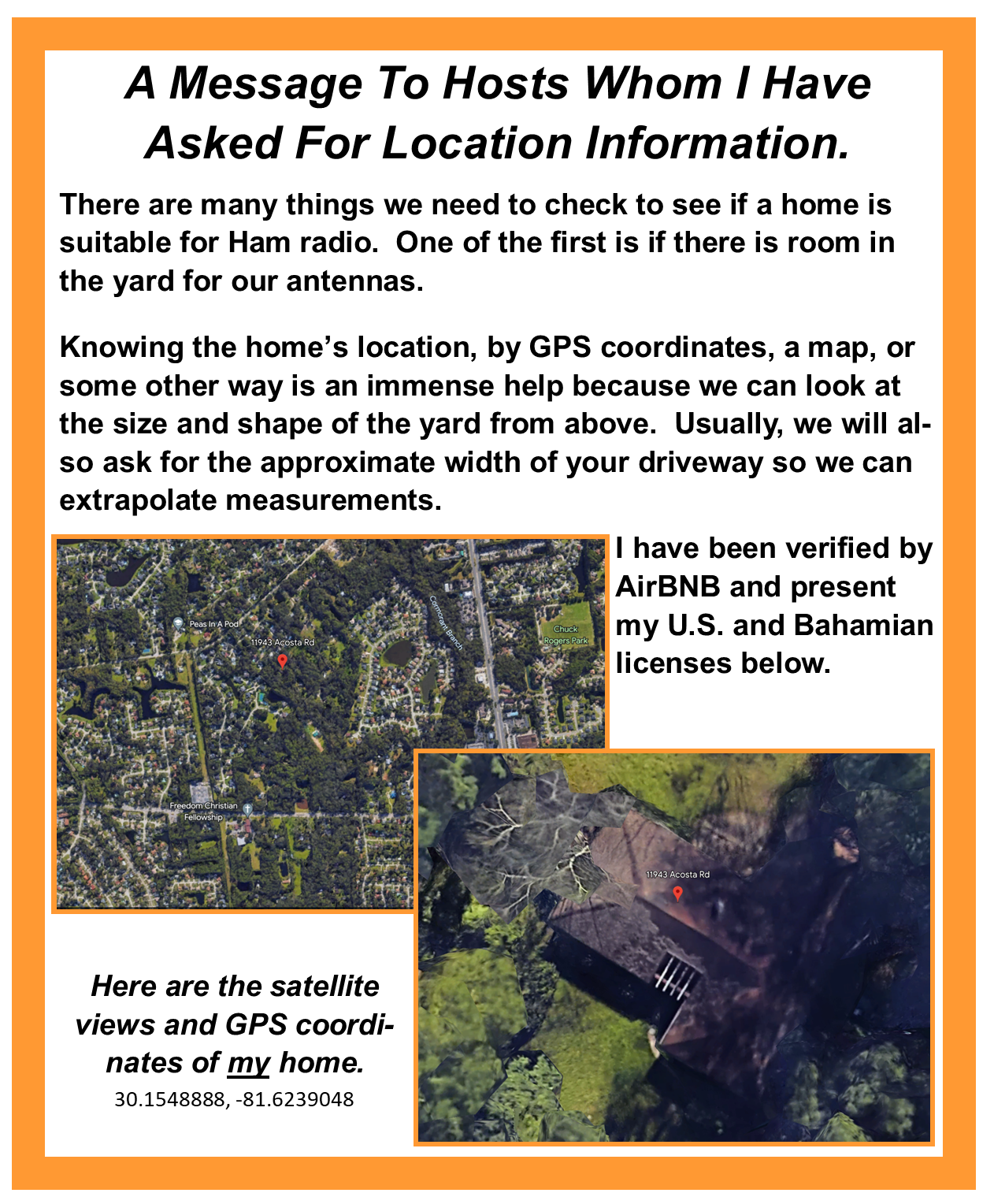

.
.
I Am A Ham - What Is A Ham?
I am a Ham radio operator, or a Radio Amateur, looking for a place to set up my antennas and compete in the world's biggest Ham radio contest. It's at the end of each October.
Hams are disaster relief responders, scientists, and hobbyists. There's 2.7 million of us in the world.
You can learn more about us if you go to Wikipedia and search Ham Radio Amateurs or click https://en.wikipedia.org/wiki/Amateur_radio.
THE INFORMATION I AM ASKING YOU FOR ENABLES ME TO SEE IF OUR ANTENNAS WILL FIT SAFELY ON YOUR HOME'S YARD, BEFORE I TRAVEL TO YOU.
I need either an overhead shot of your home, or your address, or GPS coordinates for me to look it up. I respect and accept that you may not be comfortable doing this. That's why I did it on my own home to show you I am comfortable with it (see above in the orange box) and what it looks like.
WHY SHOULD YOU WORK WITH ME?
First, MONEY.
Hams in rental vacation homes are an underserved market segment. Whoever goes after that segment will grow their business. Ask me how.
Two years ago we promoted our Bahamian rental to Hams 25,000 times in seven days.
Second, THE BAHAMAS IS LEFT OUT.
Over 30,000 Hams from over 300 countries will participate in the upcoming contest. Two years ago, my team was the only team representing The Bahamas. We won 1st place. Without us, The Bahamas would not have existed in the contest. And yet you are the 184th most-wanted country in the world (out of 340).
Third, BAHAMIAN PRIDE.
Help us hold the Bahamian Banner until a
Bahamian is ready to take it on.
What Happens When A Ham Rents your home?
You'll find a detailed explanation below.
Look back above to the orange frame to see my personal home satellite images.
REFERENCES
- Bahamian Federal License issued by URCA: C6AHB
- U.S. License issued by the U.S. Federal Communications Commission: NN2T
- Look me up: Richard Visman On the Universal License System https://www.fcc.gov/wireless/universal-licensing-system
- Look Us Up On QRZ.com, a world-wide database.
We're at www.QRZ.com/db/C6AHB and
www.QRZ.com/db/NN2T.
Home


I AM A HAM
WHAT HAPPENS WHEN A HAM RENTS YOUR HOME
INTRODUCTION
This is a discussion of what happens when a Ham Radio operator rents your vacation property.
It is important to note that although this document makes it sound like their is a large team at work, Usually the team is just one, two, or perhaps three people.
The goal of the document is for there to be no surprises for any party as the radio station is being set up and operated.
There are three sections:
1. What Is Ham Radio?
Hobbyists, Disaster Volunteers, Scientists
2. What happens outside the home.
Antennas Are Set Up, Wires are Run
3. What happens inside the home.
Wires Are Run, Equipment Is Set Up
WHAT IS HAM RADIO?
Think: CB radio and walkie talkies on steroids. We are emergency responders, supporters of science, and hobbyists. Our signals literally go around the world. We are all volunteers.
Officially we are Amateur Radio Operators, or Ham Radio Operators. We are all federally licensed. I am licensed in both The Bahamas and the U.S.
We might be some of the first people to arrive at a major disaster such as a hurricane because we can operate totally self-sufficiently to provide communications. We don't necessarily need a plug-in wall outlet for power, although generally on trips like this one we go ahead and use what is available in the building.
We support science: There's a Ham radio on the International Space Station. We participate in scientific experiments, like a mass radio wave propagation experiment during the last solar eclipse.
We are also hobbyists who just enjoy building a radio system and seeing how far we can communicate. We usually measure that in terms of countries we talk to. There are 340 countries in the world. I have talked to 234 in five years.
Of those 340 countries, The Bahamas is ranked 184 on the most-difficult-to-get list. On the tough-to-get islands list, it is even harder to get.
When we say "talk" it is usually more like a handshake, a brief exchange of specific information. Hams who carry on conversations are often called "ratchet jawers".
Some of us have the resources to buy the really good equipment and accessories. Others build most of it themselves. We have clubs and help each other.
We hold domestic and international contests, basically readiness exercises, to see how many countries, states, counties etc. we can reach in 48 hours or so. That's what is happening October 27 to 29, 2023. It is the largest contest of the year with 30,000+ participants, all of whom will want to talk to The Bahamas.
Almost every country has a Ham or two. The best I can tell about the Bahamas is that they may have 50 to 100. Here are some others:
United States 779,545
United Kingdom. 73,600
Japan. 410,000
Canada. 70,198
North Korea. 0
World-Wide Total 2,700,000
Hams have formal call signs that follow certain formats. Usually, it involves a number in the middle of some letters. My personal call signs are NN2T in the U.S., and C6AHB in The Bahamas. I believe that all Bahamian call signs start with "C6". Our operation at your place would use my C6AHB call sign.
THE CATCH 22
If a Ham's goal is to make contact with every country in the world, which generally takes about ten years, there has to be a Ham in that country to talk to. So if there are no or few Hams in a country, what do you do? In that situation, some Hams will pack up their gear and set up a Ham Radio station for perhaps a couple of weeks in the barren country. That way, all the other Hams can call in and check, say, The Bahamas off their list.
That is the second part of what we are doing. When we get on the air for the warm up period before the contest, there are going to be a lot of Hams lining up to talk to us. When you have a huge line up scrambling to get you to answer, we call that a “pile up”.
In Ham talk DX means distance. When we go somewhere to operate, we call that a DXpedition. The biggest contest of the year is October 27th to 29th. We are coming to Grand Bahama to put The Bahamas on the map in that contest. In 2021 we did it and were the only operation in all of The Bahamas. We talked to over 1,500 Hams in 81 countries on four continents, made over 25,000 brand impressions, and won our contest category.
TALK THE NIGHT AWAY
Actually not. Most Hams are now using computers and Morse code to communicate. The traditional modes were Morse code and phone (voice). There are now also several digital modes that can be very effective. As a result our operating hours and methods are evolving.
AND THE BAND PLAYED ON...
In closing...there are what all radio people call “bands”. Think of an older car radio with AM frequencies and FM frequencies on it. All the AM stations are clustered together on the AM band. All the FM stations are grouped together on the FM band. You probably push a radio button for AM or FM.
The reason for this clustering of similar frequencies is that different frequencies behave differently in the atmosphere. Day versus night, and solar flare activity all have an impact.
We Hams have a pretty good understanding of this behavior, in particular in how it relates to antennas. For a particular band, how it receives and sends a signal is critically dependent on the antenna size, design, and installation.
We Hams have the privilege of operating on about 20 bands. The contest will be limited to six bands. Our plan is therefore to set up antennas that match our band plans.
Information Resources
The Bahamian Ham community has a site on Facebook: https://www.facebook.com/bahamahamradio/
The U.S. Ham community is mostly represented by the American Radio Relay League - ARRL. They are at www.arrl.org
NEXT TOPIC: THE ANTENNA PLAN
Note: Generally we will use some but not all of these antennas.
The key things about antennas are design, size, height, and proximity to buildings, power lines, and other antennas. Your property offers some nice opportunities to work these issues to an advantage. The pictures you see are of my installations here at home and on other trips and may very well be the same devices I bring with me to the Bahamas.
The lower the frequency, the bigger the antenna needs to be. We are looking at using two or three types of antennas: an Off Center Fed Dipole, two multi-band verticals and a BuddiHEX beam.
Generally, the way you do it is not with six antennas dedicated to a specific band, but with multiple antennas that will work on multiple bands. That gives you more operating flexibility and desirable redundancy.
Which antennas we deploy will depend on several factors, some of which we won't know until we are at the site.
IMAGES ARE TO THE RIGHT -->
Image A - The Overall Layout
To help orient you, this overhead shows the potential location of the antennas. Note that we try to make them as far apart as possible from each other. And we may use only two of the vertical locations. The density of the woodlands will also be a factor.
Below image A are our plans for the dock.
This is an actual plan from another 2021 DXpedition.
Image B – The DX Commander Classic With 80 Meters Vertical
DX Commander is actually Callum McCormick , a Ham in England who makes excellent vertical antennas, and has a YouTube-type program portfolio of over 500 episodes.
This is an actual antenna I set up in The Turks and Caicos. It is 33 feet high and requires only one low set of guy wires unless the location is windy. On that Oceanside antenna we made almost 2,660 contacts as far as 6,945 km/4,340 mi..
Image C - The DXCommander Nebula eXtreme
Here it is at the beach, but now it is actually in my back yard. It is a towering 59 feet high. The height enables you to more-effectively arrange the wires it holds up, and to hold them up higher. Properly set up it works very well. It does, however, require three levels of guy wires.
Image D - The Off Center Fed Dipole
This is the Hy Power Antenna Company dipole antenna that hangs at 80 feet over my house. This we might suspend over, or on, woodlands using telescoping poles we would bring along. Although it would not be very high, it would still give us the important 160 meter band. The antenna we would use is about 280 feet of relatively thin wire. Once installed In your typical terrain it is usually hardly noticeable. We have done this several times before. Good gloves are a must.
Images E - The Hex Beam
Images E – The Hex beam is a hexagon-shaped structure just like the clothes lines of the past. It sits about 20 feet high on a mast. Different length wires on it handle different bands.
Beam antennas shoot your signal in a relatively narrow, straight direction. Like a narrow flashlight beam. Most other vertical antennas spread your signal around in some variation of a circle.
This is actually the State-Of-Art in Hex beams. The BuddiHEX is designed to be lightweight and movable. It projects a focused beam of your signal, which can be directed at the target of your choice around the world. Did you know that if you want to reach Asia you point North?
Image F- Chairs
This is at a DXpedition where we had severe problems with people walking through the antenna field. If someone trips and falls on the guy ropes a $1,500 antenna could crash down and be destroyed. We had a very close call with a neighboring antenna, so we set out chairs around the guy points. That’s why we like a fence!
What the host called private, and charged for it, really wasn't private. It was a community dock.
Image G – The Eagle One
This antenna is 33 feet high of telescoping fiberglass and is renowned for being quick to deploy. Like other folks, we have used it on our car rear bumper when we might operate from a national park. Stopped of course. It is being used as a valuable beach antenna above.
It is also good for other applications and as a back up. Generally, when we arrived at a location we will immediately set this up temporarily so that we can set up a simple radio, get on the air, and start making contacts/points while we build the rest of the station.
The diagram shows approximate positions. Final selection and placement will depend on local factors.
H: RADIALS
If you look carefully at the lower metal plate you will screw posts – see the green arrows. Look also for the yellow arrows and boxes. You will see thin black lines that emanate from the bottom of the mast. These are radials.
Generally, when a radio signal leaves a vertical antenna it's signal travels in all directions, including down Into the ground. In order to avoid wasting that energy, we place a series of five to twenty, about 32 foot long, thin wires on the ground fanning out from the antenna. This floor of wires, called a counterpoise, keeps the signal upward bound. When we're done we unhook the wires, coil them up, and take them home. However, while they are out there it would not be a good idea to mow the lawn.
I & J: GUY ROPES
This is an important safety issue. Most of these antennas require some form of guy ropes to hold them up vertical. The problem is that foot traffic, particularly of a disorganized nature, might trip a line, causing some instability. Therefore we find fenced yards attractive. We are likely to add some visibility tape to the guy lines to make them more visible. Note the yellow arrows highlighting the guy ropes.
CLEAN UP
Once we are done, everything comes down, is coiled up, and it looks like we were never there.
+++++++
INSIDE THE HOUSE
Advance Discussion With Host Our goal is to operate our station efficiently but with no negative impact upon the home. We discuss all of this with the host at the time of making a reservation.
Although potentially frustrating and time consuming, the discussion is time well spent. Just on September 16th a host was working with me and we found something that eliminated the home. He agreed that it was good to discover that now rather than when I am standing on his driveway with my gear.
The key things we need to figure out before we start are:
1) Antenna Wires: Where can we bring our antenna wires into the home? A window slightly open? We can do that while sealing the entrance from air leakage. We have several ways to do that and have done it many times.
2) Power Outlets: Where the power outlets are. Hopefully, we will identify two separate circuits to spread the load. Depending on the equipment we are using we may plug into an electric clothes dryer or stove outlet for 240 volt power. The technique is very similar to how you hook up your generator to your house in a power outage. We have also done this many times.
3) Locate The Equipment: Where will we set up the station? It has to be easily and safely accessible to both the antenna and electrical wires. It usually ends up being the dining room table.
BEFORE WE MOVE ANYTHING INTO THE HOME WE DO FOUR THINGS:
1) Document: We photograph or videotape the entire home inside and outside, including the yard. That way we know how to leave things "just like when we arrived". And, we have the basis for resolving any issues.
2) Store Fragile Items. We safely store any fragile or delicate vases, planters and other iterms that might get tipped over or otherwise damaged. They usually go into an unused bedroom or closet, wrapped in towels or sheets. They will be returned just before we leave in exactly the right place. After all, we have pictures of how we started.
3) Protect The Table: We position and protect the table we will be using, usually the dining room table. We bring table padding, thick plastic table clothes, and clips to hold it all in place.
4) Move Luggage: Next, we bring in our personal and kitchen/housekeeping bags, argue over who gets which room :-), and put our gear away, out of the way.
GET TO WORK, OUTSIDE FIRST
We identify our luggage that has inside equipment and move it inside, usually to the living room. We then get to work outside while we still have light.
We unroll cable to see how far it will go, check our plans, and focus on one easy antenna, what we call the First Up, Last Down. That enables us to get on the air as soon as possible. Once that is up, someone will go inside to set up the First Up, Last Down radio.
From that point the outside work continues based on light and weather until completed.






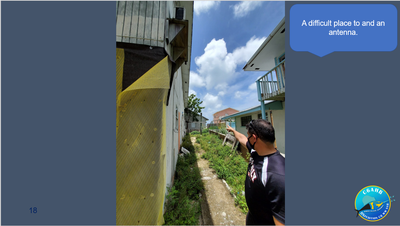




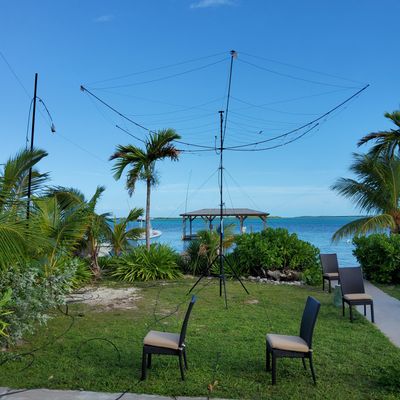

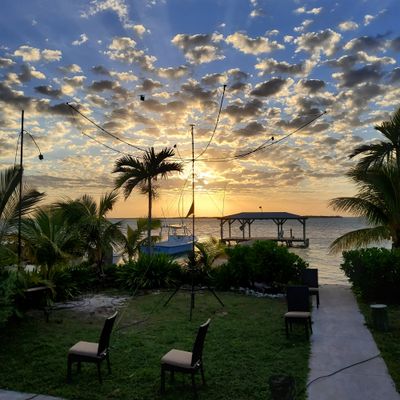

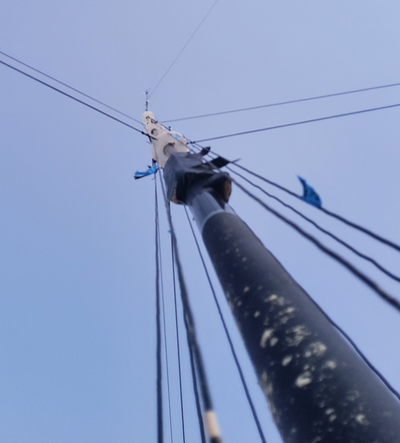























For information contact: Richard.Visman@gmail.com
..